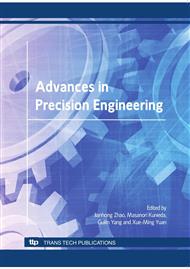p.9
p.16
p.21
p.26
p.31
p.36
p.41
p.46
p.51
Effects of Crystallographic Structure on Machining Performance with Polycrystalline Oxygen Free Copper by a Single Crystalline Diamond Micro-Tool
Abstract:
A study was carried out to investigate effects of crystallographic structure on the machining performance with polycrystalline oxygen free copper (OFC) using a single crystalline diamond (SCD) micro-tool. The SCD micro-tool used in this study fabricated with a focused ion beam (FIB) has a cutting length of around 30 µm on the primary clearance face. It was found that a change in crystallographic orientation resulted in a variation in machining force, chip thickness and shear angle, leading to a change in machined surface integrity. When a micro-size tool traverses within a grain at a machining direction aligned with a particular crystallographic orientation, the work material in front of the machining tool is found to be severely deformed. If the orientation changes to a less favorable orientation, this may lead to a much reduced shear angle, a thicker chip, striation at the chip back, higher machining forces and a degraded machined surface. This study contributes to the understanding of the physics of micro scale mechanical machining (micro-machining).
Info:
Periodical:
Pages:
31-35
Citation:
Online since:
September 2010
Authors:
Price:
Сopyright:
© 2010 Trans Tech Publications Ltd. All Rights Reserved
Share:
Citation:


